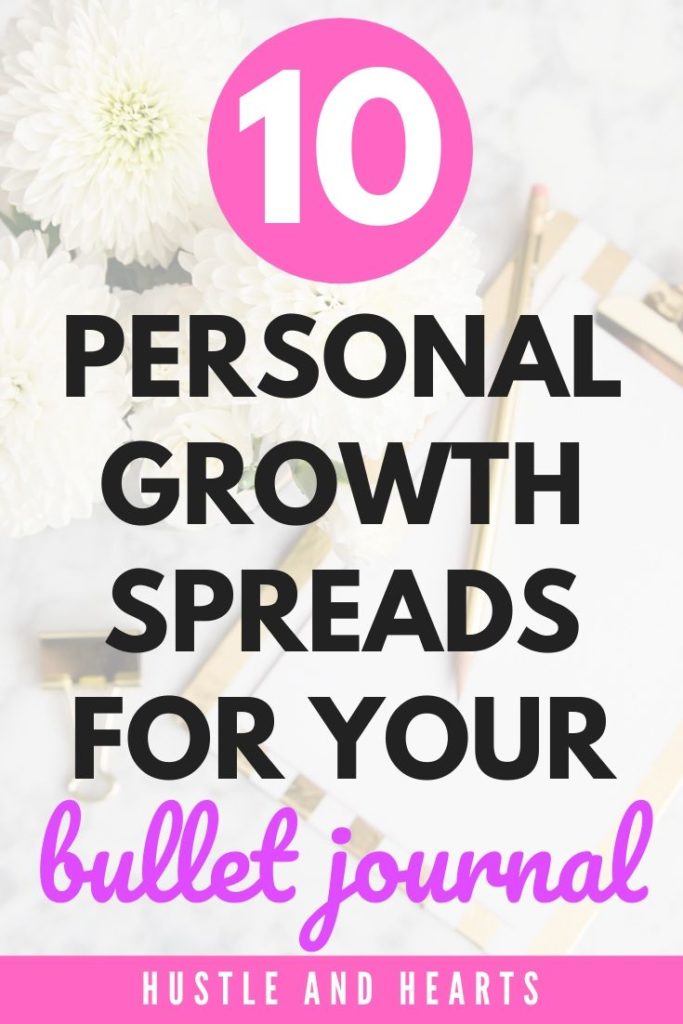I started bullet journaling at the beginning of this year, and honestly, since I’ve started, I don’t think I’ll ever go back to a regular planner. Not only has my bullet journal contributed majorly to my productivity/organization, it’s also been integral to my personal growth for the year.
Now, having said that, if you’re familiar with bullet journaling, you might be looking at this post and thinking I’m about to hit you with all the typical personal growth bullet journal spreads: habit trackers, fitness trackers, water intake trackers, etc.
But honestly, I’ve tried making these spreads and they’re just way too time consuming (especially when trying to be creative with it).
I mean, sure, they look pretty, but by the time I’m done them, are they really helping me with personal growth? Maybe a little, but probably not much.
And so, today, for those of you who also have a preference for simple bullet journal spreads, I wanted to share with you some of the ways I’ve used my bullet journal to help me with my personal growth for the year.
Just know that most of these ideas revolve around writing/journaling rather than creating artistic bullet journal spreads.
If this sounds like your cup of tea, let’s dig in!
Please note: This post does contain some affiliate links, meaning I make a small commission if your choose to purchase through one on my links. Of course, though, everything I recommend, I believe in.
First, what is a bullet journal?
I’m not going to go into too much detail here simply because if you clicked on this article, you’re probably already familiar with the concept of bullet journaling.
In general, though, a bullet journal is part day planner and part journal. It allows anyone and everyone who wants to start a bullet journal the freedom to design their planner/journal in any way that they want. You can write notes to yourself, track due dates, schedule in appointments, and write down your goals for easy reference, for example.
Having said that, there is a general method to bullet journaling that most people follow. You can find tons of articles all over the internet detailing how to bullet journal. I also have a full article on bullet journal tips for beginners. You can even read The Bullet Journal Method by Ryder Carrol (the creator of the bullet journal) if you really want to understand the method (I did and loved it!).
For today’s article on personal growth and bullet journaling, I’m generally focusing on the extra pages you can add to your bullet journal. These aren’t the standard bullet journal spreads, but are more so extra things I’ve done that I’ve found have helped me with personal growth for the year.
Let’s discuss some of those personal growth bullet journal spreads and how they’ve helped me.
NOTE: On Pinterest you’ll see plenty of bullet journal enthusiasts creating elaborate bullet journal spreads. I don’t do this with any of my spreads. I started bullet journaling trying to make everything colorful and pretty, but honestly, after months of bullet journaling, I now basically resort to my favorite black pen and maybe some colored pens if I’m feeling fancy. It’s just too time consuming and not a good use of my time if I try to make elaborate spreads
Check out this article for some of my favorite simple ways to give your bullet journal some artistic flair even if you’re not artistic.
1. Start a feel good list
This is something that I did recently, and I’m absolutely obsessed with the idea.
The inspiration came from the book The Happiness Project by Gretchen Ruben (if you haven’t read this, you really should).
The book takes place over the course of a year, and the idea revolves around actively doing things that make you happier.
While I didn’t take on a full happiness project, I did decide to make what I call a “Feel Good List.”
I put this little list in the back of my bullet journal, and all it is is simply a list of things that make me feel good.
You know, those things in life that you KNOW make you feel better, but that you rarely do (whether because you’re being lazy, or you simply forgot how good they make you feel).
Things I included on my list were wake up early, paint my nails, get fresh air, keep the house tidy, make dinner, see my friends weekly, light candles, etc.
As you can see the list is wide ranging, but basically the point is to list out everything and anything that you know makes you feel good (even if you rarely do them). This way, on a day where you’re feeling down or unmotivated, you can refer to your Feel Good List, and implement some of the ideas to hopefully make you feel better.
Trust me, sometimes all you need is a coat of nail polish to turn your day around. Keeping my Feel Good List in my bullet journal allows me to have easy reference to this list so I can be reminded what makes me feel better on a bad day.
2. Define your “worst” and “best” self with this exercise
Okay, this one might sound a little eye roll worthy, but it’s another page I keep in the back of my bullet journal and refer to often when I’m in need of a little pick-me-up for the day.
I know I got this idea from the Skinny Confidential Him and Her Podcast, but for the life of me, I can’t remember what episode it was (if someone knows, leave me a comment so I can add it in).
So basically, this little task requires you to create two columns. Label one side “Best Self’ and one “Worst Self.” Under the “Best Self” column write down all the positive characteristic traits you exhibit when you’re at your best (list as many or as little as you want). On the opposite side, list out all your worst traits.
Next, name those “selves.” They can be real names or just funny nicknames.
Whatever the case, the point is to be able to clearly call yourself out when you’re being your worst, and praise yourself when you’re being your best.
For example, I labelled my best self “Sunny” and my worst self “Tiny.” When I’m being defensive, moody, and insecure, I know I’m being “Tiny.” When I’m being helpful, empathetic, and bright, I’m being “Sunny.”
I know it seems like a small thing, but there really is something special about getting to label those traits within yourself, so that you can identify when you’re at your best and when you’re at your worst. Not to mention, just writing it down and having it in my bullet journal for easy reference solidifies the idea in my head even more.
Give it a try and I think you’ll see the value in this exercise.
3. Write a note to yourself at night for the next day
Okay, here’s an easy one.
For most bullet journalists, you keep some sort of daily log, which usually consists of your To-Do list for the day (appointments, errands, important tasks, etc.)
One thing that I like to do with my daily log is to write a little note to myself the night before.
So, for example, on Monday night, I’ll write the heading “Tuesday” for the next day, and then underneath I’ll write a note to my future self.
I like to make these notes happy, positive messages rather than generic reminders about the things I have to do for the day. This way, when I go to start my work day and consult my bullet journal, the first thing greeting me is the positive reminder.
And hey, if you really can’t think of something positive to say to yourself, you can always simply write a quote.
Either way, this little addition to my bullet journal ensures I start my day off on the right foot.
4. Write a week in review
At the end of each week, I like to write a week in review.
Sometimes this consists of two lines and sometimes it’s a whole page.
I’ll write about things that went well with my work, and other weeks it’s all about things that have happened personally.
Generally, though, the point is to simply to reflect at the end of the week. What went well? What could I do better? How much did I get done? What do I want to change next week? These are just some of the questions I’ll ask myself, but really, your week in review can be about whatever you want. Simply reflect on the week, and I think you’ll start to see the value in taking 5 minutes to write a week in review.
5. Set your intention for the day
Similarly to writing myself a note for the day, I also like to set my intention for the day. And honestly, it can be whatever you want.
A word. A mantra. A goal.
Whatever it is, writing it down and seeing it in your bullet journal throughout the day is a good reminder to keep you on track.
6. Brain dump throughout the day
I don’t know about you, but I am definitely someone who has a million thoughts running through her head throughout the day.
Ideas for my business, things I have to do, things I want to do…
Whatever it is, having these thoughts all jumbled in my head can be extremely distracting.
And so, in order to combat distraction, I started writing out my thoughts in my bullet journal throughout the day.
As mentioned, in a bullet journal you have your daily log, and, because a bullet journal gives you so much freedom, you can write whatever you want in your daily log.
I started brain dumping in my daily log.
When ideas pops in my head, I simply write them in my daily log. When I remember that I have to do something during the week, I write it in my daily log.
At the end of the day, I can review my daily log, see what I wrote, and evaluate. This way, everything is out of my head, on paper, and I’m much more inclined to focus on the task at hand (doing this also helps reduce my anxiety).
7. Write a mini journal to work through a problem
As a writer, I’m definitely someone who works through a problem better if I can write about it.
You’ll find multiple pages throughout my bullet journal where I write a mini journal to work through a problem.
This can include a pro/con list, a Q&A session with myself, or just general points that are bothering me.
Often I just write these mini journal sessions right within my daily log. This might not work for everyone if you want your daily log to remain short and sweet, but I’ve just found it’s convenient to write as it comes to me.
8. Separate “work” and “personal” To Do lists
This is an easy one, but one thing I find that helps reduce my anxiety is having separate To Do lists.
One list is for work and one is for personal.
This allows me to have some separation between my work and my personal life.
You can even break up your To Lists further if you want. For example, if you have a side project, have a separate To Do list for that. If you have kids, have a separate To List for that.
Whatever works for you, I find separating out my tasks reduces my anxiety.
9. Write a gratitude list (without expectation)
Yeah, yeah, I know, a gratitude list isn’t anything revolutionary when it comes to personal growth bullet journal spreads (everyone has one lol).
One thing that I think I do differently with my gratitude list is I don’t have any expectations for it, and I don’t force myself to commit to doing it everyday.
When I’m feeling down, cranky, or moody, I’ll just quickly write out a gratitude list.
There’s no elaborate spread, or commitment that I have to do it everyday. Because sure, while a daily gratitude practice is nice, I never stick to it, and it always feels forced. I would rather my gratitude just come out naturally when I need it, ya know?
10. Track your “wins”
And lastly, because I think so many of us are so hard on ourselves, I think it’s extremely important to track our “wins,” or the things we accomplish throughout the day, week, and/or month.
For me, I do this both monthly and daily.
For the month, I’ll track things like how many sales I make of my ebook, what my blog analytics are, etc. (more business oriented).
For the day, I simply make little notes to myself when I feel like I accomplished something and want to remind myself of it.
Even something as simple as waking up early in the morning, I’ll write down and check it off if I do it, which gives me a sense of accomplishment right at the start of the day (it’s small but checking off your whole To Do list for the day will give you a major boost).
And there we have it: that is how I use my bullet journal for personal growth.
It’s not extremely elaborate, and I intentionally don’t create complicated spreads. I know myself well enough to know that I would never stick with bullet journaling if it was taking me hours to create each spread. I’m all about that simple black pen bullet journal life!
How do you use your bullet journal for personal growth? Do you have any bullet journal tips and tricks to help you stay productive, motivated, and happy? Let me know in the comments below!
And, if you have found this post helpful and would like to save it for later/share it with your friends, feel free to use this image on Pinterest:






Leave a Reply